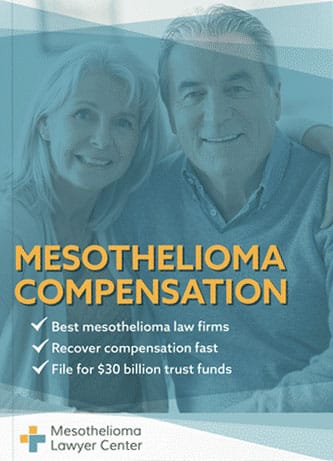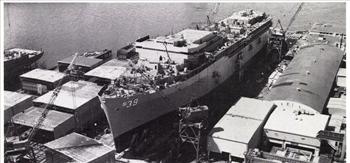Lockheed Shipbuilding and Construction Company in Seattle played an important role in constructing and repairing vessels for the U.S. Navy. It relied on asbestos for years, putting workers and Navy veterans at risk of exposure and illnesses like mesothelioma.
If you or a loved one suffer from mesothelioma, asbestos-related lung cancer, or asbestosis, you may qualify for substantial compensation. Currently, there is over $30 billion in asbestos trust funds, awaiting those who’ve been diagnosed with an asbestos illness. Fill out our form to receive our free Financial Compensation Packet. Our packet is loaded with information on experienced mesothelioma attorneys in your area, how to file a claim for asbestos trust funds, how to get paid in 90 days, and more.


FREE Financial Compensation Packet
- Info on law firms that will recover your HIGHEST COMPENSATION
- Learn how to get paid in 90 days
- File for your share of $30 billion in trust funds

Did Lockheed Shipbuilding Use Asbestos?
Most U.S. shipyards used asbestos for decades. Asbestos went into hundreds of components used to build and repair ships. It was also found in buildings at shipyards and equipment and vehicles.
Lockheed Shipbuilding used asbestos during its operations for many years. It operated during the peak years of asbestos use in the U.S., from the 1930s through the 1970s.
Lockheed Shipbuilding and Construction Company History
The origin of Lockheed Shipbuilding dates back to the Puget Sound Bridge and Dredging Company, founded in 1898. It entered the shipbuilding industry in the 1930s.
- Lockheed Aircraft Company bought the shipyard in 1959, and it became the Lockheed Shipbuilding and Construction Company. Lockheed Shipbuilding was located on the west side of Seattle’s Harbor Island along the Duwamish River.
- The shipyard built ferries for the state of Washington and many vessels for the Navy during and after World War II. It also built commercial vessels, like tugs, dredgers, and ice breakers.
- The company continued to build vessels during the 1960s, including the USS Rathburn, USS Stein, USS Reasoner, USS Shreveport, and more.
- By the time Lockheed bought the shipyard, it was already highly contaminated with asbestos and other toxic substances.
- The shipyard, spread out over 18 acres, had three dry docks, five piers, and a shipway. Lockheed was just one of several companies that built and repaired vessels along the Duwamish River, causing contamination and pollution issues.
- This would ultimately lead to the area becoming a Superfund Site. The heavy pollution was one reason the Lockheed shipyard closed in 1987.
How Did Lockheed Shipbuilding Use Asbestos?
Shipyards used asbestos for decades for many reasons. Primarily, asbestos was useful in constructing and repairing ships because it is an excellent insulator. It is also a good fireproofing material.
During the years of its peak use, asbestos was inexpensive and abundantly available. All these properties made it a valuable substance in shipyards.
Hundreds of components with asbestos went into ships repaired and built at Lockheed, including:
- Insulation
- Pipe lagging
- Cement
- Adhesives
- Boilers
- Pumps
- Gaskets
- Valves
- Ceiling, floor, and wall panels
Shipyards like Lockheed also had asbestos insulation in buildings. The equipment and vehicles used at shipyards had asbestos in friction parts, like brakes or clutches.
Who Was Exposed to Asbestos at Lockheed Shipbuilding?
Anyone working at Lockheed during the years of asbestos use was at risk of asbestos exposure. Handling asbestos materials causes it to shed tiny fibers that workers can inhale.
The workers at greatest risk of asbestos exposure and later illnesses handled asbestos directly or worked very close to people who did:
- Installation installers
- Repair workers
- Pipefitters
- Boiler workers
- Mechanics
These workers often had to cut into or manipulate asbestos materials. Doing so without proper protective gear led to significant exposure.
Asbestos-Related Lawsuits Against Lockheed Shipbuilding
Many of the people exposed to asbestos while working at Lockheed Shipbuilding eventually developed related illnesses, like mesothelioma. Some of these people took legal action, suing asbestos companies that supplied the shipyard or Lockheed itself.
A significant mesothelioma lawsuit against Lockheed occurred when a father and son both developed asbestosis and, ultimately, mesothelioma.
Reuben Arnold (father) and Daniel Arnold (son) both worked at Lockheed. Reuben, however, was a general contractor at Lockheed. His employer at the time was E.J. Bartells.
On August 31, 2010, the Court of Appeals of Washington ruled that Lockheed was responsible for ensuring its workers were safe from the dangers of asbestos.
This went for Lockheed employees and contractors who worked at the shipyard. Reuben, a subcontractor, worked at the shipyard as an insulator during the early 1960s.
After Reuben was diagnosed with mesothelioma, his son, Daniel, developed the disease after second-hand exposure from his father’s work clothing. Both father and son died within 15 months of each other.
Under Washington state law, companies who hire contractors and subcontractors are ultimately responsible for worker safety.
Lockheed claimed it did not work as a general contractor, but the court rejected their claim after evidence confirmed that the company directed how Arnold performed his work. Per Washington law,
“An employer of an independent contractor is generally not liable for injuries to the independent contractor’s employees. Kelley v. Howard S. Wright Constr. Co., 90 Wn.2d 323, 330, 582 P.2d 500 (1978). An exception exists where the employer retains control over some part of the contractor’s work. Kelley, 90 Wn.2d at 330. An employer retains control if the employer retains “the right to direct the manner in which the work is performed.”
Arnold v. Saberhagen Holdings, Inc., et al.,
Ultimately, however, in 2011, the appeal was reversed when the court approved a summary judgment that Lockheed subsequently filed.
Lockheed Shipbuilding Superfund Site
In addition to asbestos, Lockheed Shipbuilding contained numerous other toxins, including chemical contaminants, arsenic, lead, zinc, and mercury.
The landfills around the shipyard were extremely unsafe, causing concern for area residents.
Lockheed had two major shipyard areas: Shipyard 1 and Shipyard No. 2 (Yard II). Yard II is where most of the shipbuilding and repair work took place.
In 2007, the Environmental Protection Agency (EPA) designated Shipyard 2 as a Superfund site. By 2010, the site’s name was changed to the Lockheed West Seattle Superfund Site. Cleanup began shortly after.
Sandblasting operations close to Yard II’s dry docks and shipway caused a lot of contamination.
According to the Lockheed Martin Corporation, contaminants associated with a large amount of sandblasting activities left excessive amounts of pollutants around the surrounding areas of the dry docks and shipways.
Seeking Asbestos Compensation After Working at Lockheed Shipbuilding
If you worked at Lockheed Shipbuilding during the years of asbestos use, talk to an asbestos law firm to find out what you can do about it. Victims of asbestos exposure are often eligible to file a lawsuit or make a claim with an asbestos trust fund to seek compensation.
Many asbestos lawsuits end in settlements for people diagnosed with mesothelioma. They may also end in settlements for the families of asbestos victims who died from mesothelioma.
Asbestos companies that went bankrupt cannot be sued for damages. Many of these companies set up trust funds to compensate victims. Some of the companies with trusts associated with asbestos at Lockheed Shipbuilding include:
- Babcock & Wilcox
- Combustion Engineering
- Fibreboard
- NARCO
- Owens Corning
- Pittsburgh Corning
Additional Help and Resources
If you’ve been injured by mesothelioma, asbestos-related lung cancer, or asbestosis, keep in mind that there is a good chance that you’ll qualify for considerable compensation. Remember to fill out our form to get your free Financial Compensation Packet, with information on asbestos and mesothelioma lawyers. If you have questions or need additional assistance, contact us at 800-793-4540.

Paul Danziger
Reviewer and EditorPaul Danziger grew up in Houston, Texas and earned a law degree from Northwestern University School of Law in Chicago. For over 25 years years he has focused on representing mesothelioma cancer victims and others hurt by asbestos exposure. Paul and his law firm have represented thousands of people diagnosed with mesothelioma, asbestosis, and lung cancer, recovering significant compensation for injured clients. Every client is extremely important to Paul and he will take every call from clients who want to speak with him. Paul and his law firm handle mesothelioma cases throughout the United States.
References
- Hedley-Whyte, J. and Milamed, D.R. (2008, September). Asbestos and Ship-Building: Fatal Consequences. Ulster Med. J. 77(3), 191-200.
Retrieved from: https://www.ncbi.nlm.nih.gov/pmc/articles/PMC2604477/ - U.S. Environmental Protection Agency. (2023, August 8). Asbestos Laws and Regulations.
Retrieved from: https://www.epa.gov/asbestos/asbestos-laws-and-regulations - Court of Appeals of Washington. (2010, August 31). Arnold v. Saberhagen Holdings, Inc.
Retrieved from: https://www.courtlistener.com/opinion/2364467/arnold-v-saberhagen-holdings-inc/ - U.S. Environmental Protection Agency. (n.d.). Superfund Site: Lockheed West Seattle Seattle, WA.
Retrieved from: https://cumulis.epa.gov/supercpad/SiteProfiles/index.cfm?fuseaction=second.Cleanup&id=1002655#bkground
